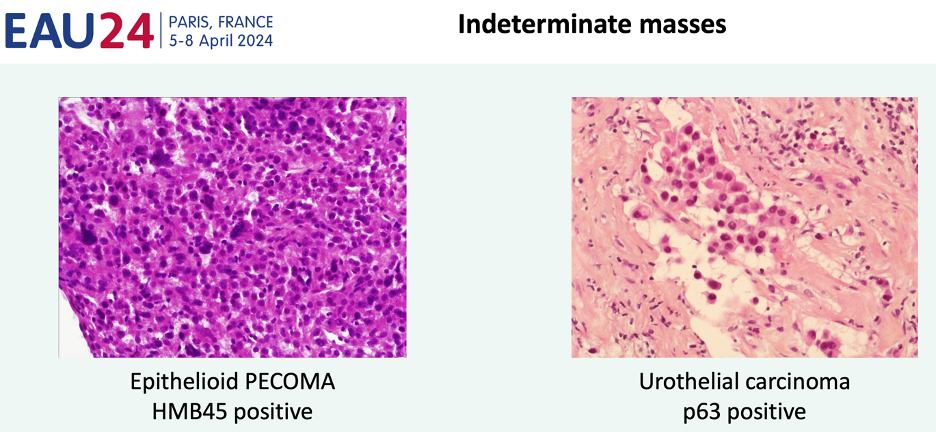(UroToday.com) The 2024 European Association of Urology (EAU) annual congress held in Paris, France was host to a plenary session addressing imaging-related controversies for the staging of genitourinary cancers. Professor Yves Allory discussed why biopsy and pathology are the ‘solution’ for the initial staging of renal cell cancer (RCC).
Professor Allory began by noting that a renal mass biopsy plays no role in the initial ‘staging’ of renal cell cancer; however, staging assumes a prior diagnosis and imaging alone is not always sufficient to confirm such a diagnosis.
Currently, the EAU guidelines state that percutaneous renal mass biopsies may be used to:
- Obtain histology from radiologically indeterminate renal masses
- Select patients with small renal masses to evaluate eligibility for active surveillance
- Obtain histology before or simultaneously with ablative treatments
- Select the most suitable form of medical and surgical strategy in the setting of metastatic disease
Although clear cell renal cell carcinoma is the most common histologic subtype of renal masses, there remains a broad range of possible histologic entities (including benign ones), as summarized below:

Contemporary biopsy series reflect the WHO 2022 renal tumor classification and its complexity. In an unpublished series from 2022 by Robin R. and Nourieh M., 81 renal mass biopsies were performed between 2020 and 2021. Of these 81 biopsies, 94% were contributive. Notably, 26% of patients had a benign diagnosis. There was 95% concordance between the biopsy and surgical specimen. An important limitation was that grade was frequently underestimated.

Professor Allory highlighted examples of benign tumors that can be misclassified as malignant lesions if renal mass biopsies are forgone:

Examples of indeterminate renal masses include epithelioid PECOMA, urothelial carcinoma, lymphoma, sarcoma, metastases, and adrenal carcinoma, among others.

Professor Allory concluded as follows with regards to renal mass biopsies:
- Highly reliable for diagnosis, allowing immunohistochemical and molecular evaluation
- Reflect the full range of renal tumor diagnosis
- Complementary to conventional and molecular imaging for initial staging
- Main limitations: feasibility, adverse events (rare), grade underestimation
- One strong option …for (select) patients
Written by: Rashid Sayyid, MD, MSc – Society of Urologic Oncology (SUO) Clinical Fellow at The University of Toronto, @rksayyid on Twitter during the 2024 European Association of Urology (EAU) annual congress, Paris, France, April 5th – April 8th, 2024
References:
- Richard PO, Jewett MAS, Tanguay S, et al. Safety, reliability and accuracy of small renal tumour biopsies: results from a multi-institution registry. BJU Int. 2017;119(4): 543-549.
- Marconi L, Dabestani S, Lam TB, et al. Systematic Review and Meta-analysis of Diagnostic Accuracy of Percutaneous Renal Tumour Biopsy. Eur Urol. 2016; 69(4): 660-673.
- Chau M, Thia I, Saluja M. The Utility of Renal Mass Biopsy in Large Renal Masses. Res Rep Urol. 2023(15): 403-408.


